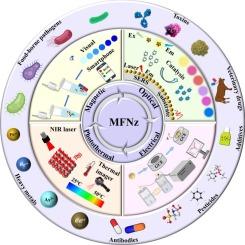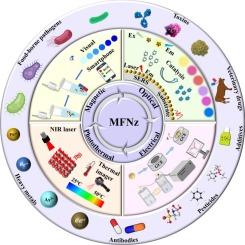Harness of multifunctional nanozymes: Focusing on material construction to food safety detection and monitoring
IF 23.5
1区 化学
Q1 CHEMISTRY, INORGANIC & NUCLEAR
引用次数: 0
Abstract
As people pay more and more attention to food safety, the demand for fast, sensitive and reliable detection technologies is also growing. However, traditional detection technologies usually have the disadvantages of low sensitivity, complicated procedures and poor adaptability to various food matrices. Natural enzymes, due to their rapid reaction rates, are widely used in various rapid detection platforms, driving the development of traditional detection methods. However, the complexity of their extraction and relatively high cost limit their application. Nanozymes, which mimic the catalytic activity of natural enzymes, offer advantages, including lower costs, ease of preparation, and excellent stability, making them a promising alternative to natural enzymes. However, most nanozymes are monofunctional, and such single-function systems often exhibit limited substrate scope, poor adaptability, and weak signal amplification, restricting their broader application. In contrast, multifunctional nanozymes (MFNZs) can combine enzyme-mimicking catalysis (e.g., peroxidase) with the intrinsic physical properties (optical, magnetic, photothermal) endowed by nanoscale coordination structures, providing a revolutionary solution for food safety by enabling synergistic cascade reactions, signal amplification, and simplified sample processing. However, how to accurately combine multiple functions based on the different mechanisms of action of MFNZs has not yet been clearly explained. Therefore, it is necessary to conduct a systematic review of the design principles, classification and functional combination of MFNZs. This review systematically explores the rational design strategies, catalytic mechanisms, and functional classification of MFNZs, emphasizing how engineered coordination environments at the nanoscale underpin their multifunctionality. We assess the application of MFNZ-based multi-mode biosensors for detecting diverse food contaminants. This review aims to provide foundational insights for advancing MFNZs as powerful, coordination chemistry-driven tools in next-generation food safety monitoring and biosensing.


多功能纳米酶的利用:聚焦于食品安全检测与监测的材料构建
摘要随着人们对食品安全的日益重视,对快速、灵敏、可靠的检测技术的需求也越来越大。然而,传统的检测技术往往存在灵敏度低、程序复杂、对各种食品基质适应性差等缺点。天然酶由于反应速度快,被广泛应用于各种快速检测平台,带动了传统检测方法的发展。但其提取的复杂性和较高的成本限制了其应用。纳米酶可以模拟天然酶的催化活性,具有成本低、制备方便、稳定性好等优点,是天然酶的理想替代品。然而,大多数纳米酶是单功能的,这种单功能系统往往表现出底物范围有限,适应性差,信号放大弱,限制了它们的广泛应用。相比之下,多功能纳米酶(MFNZs)可以将酶模拟催化(如过氧化物酶)与纳米级配结构赋予的固有物理性质(光学、磁性、光热)结合起来,通过实现协同级联反应、信号放大和简化样品处理,为食品安全提供革命性的解决方案。然而,如何根据MFNZs不同的作用机制,准确地结合多种功能,目前还没有明确的解释。因此,有必要对MFNZs的设计原则、分类和功能组合进行系统的综述。本文系统地探讨了MFNZs的合理设计策略、催化机制和功能分类,强调了纳米尺度上的工程协调环境如何支撑其多功能性。我们评估了基于mfz的多模式生物传感器在检测各种食品污染物中的应用。本综述旨在为MFNZs在下一代食品安全监测和生物传感中作为强大的协同化学驱动工具提供基础见解。
本文章由计算机程序翻译,如有差异,请以英文原文为准。
求助全文
约1分钟内获得全文
求助全文
来源期刊

Coordination Chemistry Reviews
化学-无机化学与核化学
CiteScore
34.30
自引率
5.30%
发文量
457
审稿时长
54 days
期刊介绍:
Coordination Chemistry Reviews offers rapid publication of review articles on current and significant topics in coordination chemistry, encompassing organometallic, supramolecular, theoretical, and bioinorganic chemistry. It also covers catalysis, materials chemistry, and metal-organic frameworks from a coordination chemistry perspective. Reviews summarize recent developments or discuss specific techniques, welcoming contributions from both established and emerging researchers.
The journal releases special issues on timely subjects, including those featuring contributions from specific regions or conferences. Occasional full-length book articles are also featured. Additionally, special volumes cover annual reviews of main group chemistry, transition metal group chemistry, and organometallic chemistry. These comprehensive reviews are vital resources for those engaged in coordination chemistry, further establishing Coordination Chemistry Reviews as a hub for insightful surveys in inorganic and physical inorganic chemistry.
 求助内容:
求助内容: 应助结果提醒方式:
应助结果提醒方式:


